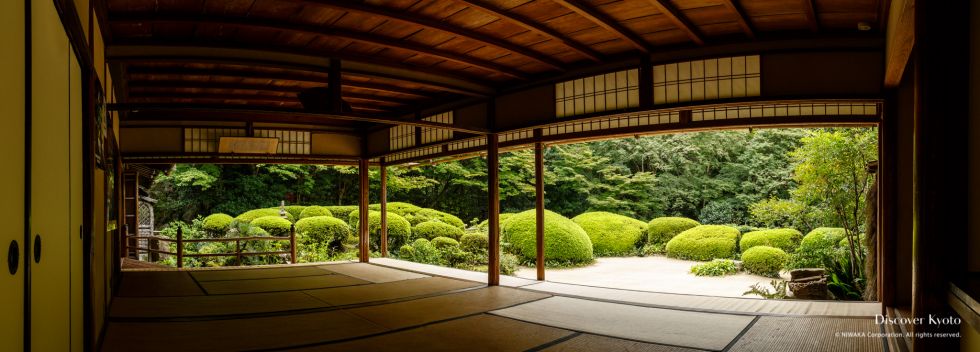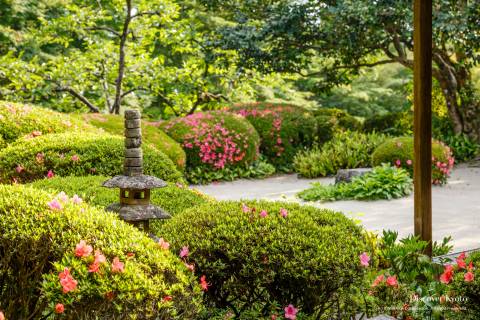Shisen-dō Jōzan-ji|詩仙堂丈山寺
Overview

The former hermitage of Ishikawa Jōzan, a samurai famous as a scholar of Chinese literature as well as a landscape architect, Shisen-dō served as a retirement villa in Kyoto once he left military service. Shisen-dō (officially named Ōtotsuka) received its moniker from the portraits of Chinese poets displayed in the main room. After making your way to the hermitage through a bamboo path, you can head first to the smooth tatami mat of the main hall and enjoy the garden scenery. Shisen-dō boasts some interestingly pruned azalea bushes and the clever use of empty space with a backdrop of trees that makes for lush colors in spring and summer, as well as stunning oranges in the fall. After taking your time to explore the main hall’s artifacts and classic décor, you can step out for a stroll to enjoy the small pond and interestingly layered garden. The sound of a bamboo water fixture thunking steadily as it fills, spills, and refills only adds to the feeling of the hermitage where hopefully you can steal a moment away from the hustle and bustle of the city.
The sound of a bamboo water fixture thunking steadily as it fills, spills, and refills only adds to the feeling of the hermitage where hopefully you can steal a moment away from the hustle and bustle of the city.
Features
Poet’s Hermitage

The main hall at Shisen-dō features the Shisen no Ma, the “Room of Great Poets”, famous for the centuries old portraits of 36 famous Chinese poets deemed exceptional by Jōzan and Hayashi Razan, a Neo-Confucian philosopher, and painted by Kanō Tan'yū, a famous artist from the Kanō school in the 1600s. Now operating as a temple, Shisen-dō has a Buddhist altar set up in a recessed room within the old hermitage with an image of Merōfu Kannon enshrined within. One of the 33 incarnations of Kannon, the Goddess of Compassion, Merōfu Kannon is quite a rare depiction. There are also artifacts such as a wooden carving said to come from the original Fushimi Castle, but the main draw is sitting in the tatami mat rooms facing the garden and taking in the lovely sight while relaxing.
Satsuki Azalea Garden

The original master of Shisen-dō was renowned as a garden designer, and his appreciation for the art shows through in what you can see even today. The view from the main hall is of late-May blooming satsuki azaleas, the bushes pruned into large, round shapes reminiscent of mountains with a stone pagoda placed in their midst. Making use of empty space with swathes of white sand and the distance between the azaleas and the backdrop of maple trees, it’s hard to muster the motivation to leave the main hall’s garden view. However, stairs lead around the azaleas and down to a lower level of the garden that can be enjoyed on a stroll, with a small pond and other seasonal flowers. A famous sōzu is also placed in the garden, said to be the first time this sort of device was utilized in gardens and not fields. A type of shishi-odoshi originally used to scare away wild animals, water trickles into the sōzu until the bamboo tube’s balance changes and it tips over, lets the water out, then falls back into place with a hollow thunk! This sound is supposed to allow the listener to further appreciate the silence in its absence.
History
The history of Shisen-dō began with the Tokugawa household samurai Ishikawa Jōzan (1583 – 1672). Serving as Tokugawa Ieyasu’s personal attendant from the age of 16, Jōzan accompanied Ieyasu into battle at the Siege of Osaka Castle in 1615, which led to the unrivaled ascension of the Tokugawa shogunate. After the battle, in his early 30s, Jōzan retired from military service and instead turned to scholarship. For the next fifteen years he found employment as a tutor to the Asano clan, feudal lords of Hiroshima, in order to make a living and support his ailing mother. However, upon her death, Jōzan left Hiroshima for Kyoto and in 1641 completed his hermitage: Shisen-dō.
Shisen-dō served as his retirement villa until his death at age 90 in 1672. Over the years Jōzan had become famous as a scholar of Chinese literature as well as a landscape architect and calligrapher. Several decades after the original owner’s passing, Shisen-dō came into the care of a Buddhist priest from the Shingon sect. Buddhist priests continued to inherit care of the hermitage until 1743, when a Zen nun under sponsorship from an imperial prince took over the position. Since then, Zen practitioners have been in charge of maintaining this lovely hermitage, which is officially considered a sub-temple of Soto Zen head temple Eihei-ji.
Access
Address
〒606-8154 京都府京都市 左京区一乗寺門口町27
| TEL | 075-781-2954 |
| FAX | 075-721-9450 |
| WEB | http://www.kyoto-shisendo.com/En/top.html |
Admission
- General Admission: ¥500
- High School Students: ¥400
- Junior High School, Elementary School Students: ¥200
Hours
- General Admission: 09:00 - 17:00
- Closed: May 25th (anniversary of Jōzan’s death)
Transportation
- Eizan Railway ⇒ Ichijō Station ⇒ 15 minutes walking
- Kyoto Station ⇒ City Bus Route Number 5 ⇒ Ichijōji Sagarimatsuchō Bus Stop ⇒ 7 minutes walking
Gallery
-




 +16
+16
